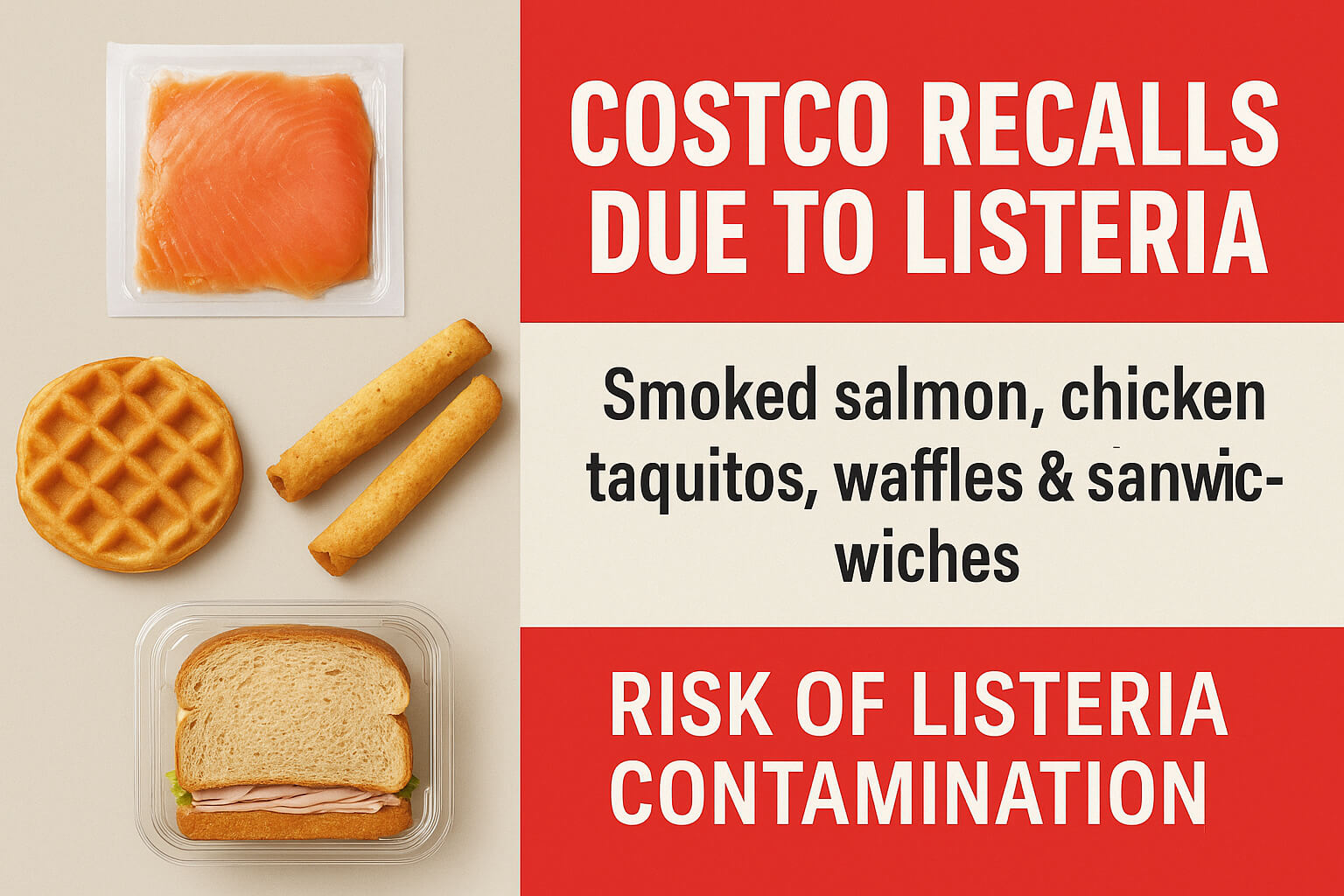In today’s world, food safety recalls are more than just headlines they’re wake-up calls reminding us how crucial it is to know what we’re putting on our plates. Even trusted retailers like Costco, known for their high standards and customer loyalty, aren’t immune to these challenges. Recently, concerns over Listeria
contamination have led to the recall of several ready-to-eat products from Costco shelves. This article takes a closer look at what Listeria really is, why these product recalls are happening, how they could affect your health, and what steps you should take if you’ve purchased any of the affected items.
Understanding Listeria and Listeriosis
What is Listeria?
Listeria is a type of bacteria that, while invisible to the eye, can have a devastating impact on human health. Found in contaminated food, especially refrigerated or ready-to-eat items, this pathogen can cause a serious illness called listeriosis. What makes Listeria particularly dangerous is its ability to grow even in cold environments like your fridge and affect people with weakened immune systems, pregnant women, newborns, and the elderly most severely. Recognizing the presence of Listeria in food isn’t easy, which is why companies like Costco act quickly when there’s any sign of contamination.
Listeria monocytogenes may sound like just another scientific term, but behind the name lies a silent and dangerous threat. This harmful bacterium has the power to turn everyday food into a serious health hazard. Unlike many other germs, Listeria can survive and grow even in cold temperatures quietly spreading through refrigerated foods like deli meats, cheeses, and packaged meals. Though it’s invisible and often undetectable without testing,
its effects can be life-threatening, especially for those with weakened immune systems, pregnant women, and the elderly. Understanding what this bacterium is and how it works is the first step in protecting your family’s health.
Where Is Listeria Found?
Listeria is more common in our environment than most people realize. This harmful bacteria can live in places like soil, water, and even animal feces and from there, it can make its way into the food we eat. Raw foods, unwashed produce, and improperly handled meats are especially vulnerable to contamination. That’s why even everyday items can sometimes become unexpectedly dangerous.
A Unique Threat: Grows in the Cold
Unlike most bacteria that die off in cold conditions, Listeria is uniquely dangerous because it can grow and multiply even in refrigerated temperatures. That means foods stored in your fridge — things you assume are safe can quietly become a breeding ground for infection. This makes Listeria particularly tricky to detect and control.
What Is Listeriosis?
Listeriosis is the serious illness caused by consuming food contaminated with Listeria. While it might start with mild symptoms, the consequences can be devastating especially for vulnerable individuals. What makes this infection so frightening is how quietly it can spread through food without any visible signs of danger.
Common Symptoms
Symptoms of listeriosis often feel like the flu: fever, muscle aches, chills, nausea, and diarrhea. In some cases, the infection can spread to the nervous system, causing headaches, confusion, and even convulsions. Because it mimics common illnesses, it’s easy to overlook until it becomes serious.
Who’s at Risk?
While anyone can be affected, listeriosis poses the greatest threat to certain high-risk groups. Pregnant women may suffer miscarriage, stillbirth, or premature delivery. Newborns and the elderly can develop severe infections, and people with weakened immune systems face a higher chance of complications or even death. For these groups, what starts as a simple stomach bug can quickly turn into a life-threatening condition.
Incubation Period
One of the most challenging aspects of listeriosis is its incubation period. Symptoms can take anywhere from a few days up to 70 days to appear after eating contaminated food. This long delay often makes it difficult to trace the source of the infection, allowing it to silently affect more people before action is taken.
Why Costco Recalls Occur
Costco’s Role in Food Safety
As one of the largest retail chains in the world, Costco handles massive volumes of food products every single day. With shelves stocked from a wide range of suppliers, the company plays a critical role in protecting public health. While Costco is known for maintaining high standards, the sheer scale of its operations makes ensuring food safety a constant and complex challenge. Every product must meet strict safety checks because even a single contaminated batch can impact thousands of families.
How Contamination Can Occur
Despite best efforts, contamination can sometimes slip through the cracks. It often starts at the source — in the raw ingredients supplied by third-party vendors. If these ingredients are tainted with harmful bacteria like Listeria and not properly tested, they can end up in consumer hands. Contamination can also happen during the processing and packaging stages. Shared equipment, poor hygiene, or unsafe environments can all lead to cross-contamination. In some cases, it’s a breakdown in quality control, either at the supplier’s facility or during Costco’s own testing, that allows unsafe products to reach the public.
How the Recall Process Works
When a potential threat is detected, Costco doesn’t wait. The recall process is initiated quickly to remove affected products from store shelves and prevent further sales. Notices are sent to customers who may have purchased the items, often through direct communication like email or membership alerts. The company also cooperates closely with the FDA and public health officials to investigate the cause, trace the contamination source, and ensure that corrective measures are taken. The goal is always the same to protect consumer safety and prevent further harm.
How the Recall Process Begins and What Happens Next
The recall process typically starts when something triggers concern often it’s a routine test conducted by a supplier or Costco itself, or sometimes it’s a public health investigation following reports of consumer illness. If a product tests positive for dangerous bacteria like Listeria, it sets off immediate red flags that demand swift action.
At this point, regulatory agencies such as the FDA (Food and Drug Administration) and CDC (Centers for Disease Control and Prevention) step in to assess the situation. These authorities work alongside Costco and other retailers to trace the contamination source, understand the scale of the issue, and determine which products need to be pulled from shelves.
Costco, known for its proactive safety policies, takes fast action. Once a recall is confirmed, the company immediately removes all affected products from store shelves and distribution centers. They notify impacted customers often through emails, texts, or app alerts especially since most purchases are linked to membership accounts. In addition, Costco issues public recall notices to ensure anyone who may have purchased the product knows exactly what to do. Every step in the process is designed to prioritize customer health and prevent further risk.
IV. Recent Examples of Costco Listeria Recalls
Over the years, Costco has faced several Listeria-related recalls, reminding us just how vulnerable even trusted brands can be when it comes to food safety. These incidents highlight the importance of constant vigilance and routine testing in today’s complex food supply chain.
Some of the recalled products have included popular everyday items like pre-made salads, cooked chicken dishes, packaged cheeses, and creamy dips foods many families pick up during their regular Costco runs. In early 2024, one major recall was linked to Rizo-López Foods, a supplier whose dairy-based products were associated with a widespread Listeria outbreak. This incident affected multiple retailers, including Costco, and led to the removal of several cheese-based items from shelves.
What’s important to note, however, is Costco’s proactive approach during such events. As soon as a contamination risk is identified, the company initiates a recall process pulling products, alerting customers, and working closely with health authorities to minimize potential harm. These swift actions show Costco’s ongoing commitment to customer safety, even when the issue originates from outside suppliers.
V. What Consumers Should Do
Stay Updated on Recalls
In a world where food recalls can happen without warning, staying informed is your best defense. Keep an eye on Costco’s official website for recall notices, follow trusted news sources, and regularly check food safety websites like the FDA or CDC. If you’re a Costco member, don’t ignore those emails or app notifications — they could contain urgent information about a product in your kitchen.
If You Have a Recalled Product
First and most importantly do not eat it. Even if the food looks and smells fine, it could still be contaminated. To protect yourself and your family, safely dispose of the product. The best way to do this is to seal it in a plastic bag, double-bag it if possible, and throw it away to prevent accidental exposure. Alternatively, Costco allows returns of recalled items just bring it back for a full refund, no questions asked.
Recognize Symptoms and Seek Help
If you’ve already consumed a recalled product and start experiencing flu-like symptoms such as fever, muscle aches, nausea, or diarrhea, it’s important to take them seriously especially if you’re pregnant, elderly, or have a weakened immune system. In these high-risk groups, Listeria can cause severe complications. If symptoms appear, don’t wait contact a healthcare provider immediately and mention the possibility of Listeria exposure.
If You Feel Sick After Eating a Recalled Product
If you’ve eaten a product that was later recalled and start to feel unwell don’t ignore the signs. Symptoms like fever, chills, nausea, or muscle aches could be more than just a passing bug. Reach out to your doctor as soon as possible, especially if you’re in a high-risk group. Be sure to mention that you may have been exposed to Listeria through a recalled food item this information can help guide proper testing and treatment.
Preventing Listeria at Home: Simple but Powerful Habits
While recalls may be out of your hands, there’s a lot you can do at home to reduce the risk of Listeria and other foodborne illnesses. Start with the basics: always wash your hands before and after handling food. Use separate cutting boards for raw meats and vegetables to prevent cross-contamination.
Make sure you cook food to the right internal temperatures especially meat, poultry, and leftovers. Listeria can survive in cold, but it can’t survive heat. Keep your refrigerator clean by wiping up spills quickly, checking expiration dates, and sanitizing shelves regularly. These small steps can go a long way in protecting your health and your family.
Conclusion
Understanding the risks posed by Listeria and the reasons behind food recalls isn’t just about reading headlines it’s about protecting our homes and our loved ones. These recalls may seem alarming, but they serve a crucial role in preventing the spread of dangerous illnesses like listeriosis.
Costco’s swift action during recall events is not a sign of failure it’s a reflection of a responsible company putting customer health first. By acting quickly, removing products, and notifying the public, they demonstrate transparency and a strong commitment to food safety.
Still, the responsibility doesn’t end at the store. As consumers, we all play a role in safeguarding our health. Staying informed, handling food properly, and recognizing early symptoms of illness are essential habits in today’s world. Food safety is a shared journey and by staying vigilant, we can all contribute to a healthier, safer community.
FAQs About Costco Recalls and Listeria
Q1. What is the latest Costco recall in 2024?
As of 2024, Costco has issued several recalls due to food safety concerns. One of the most serious included a recall of frozen chicken taquitos linked to deadly bacteria, raising alarms among consumers and prompting immediate action.
Q2. Has Costco recalled smoked salmon recently?
Yes, Costco recently recalled batches of smoked salmon due to potential Listeria contamination. Customers were urged to check product labels and return affected items for a full refund.
Q3. Why were Costco’s Kirkland eggs recalled?
Costco recalled over 10,000 cartons of Kirkland Signature eggs after concerns about potential salmonella contamination. The recall was precautionary and aimed to protect public health.
Q4. What’s the reason behind Costco recalling butter?
Costco issued a recall on Kirkland Signature butter in certain regions due to a missing allergen label for milk. This posed a serious risk for people with dairy allergies.
Q5. Why were baby wipes recalled at Costco?
Although less common, Costco has also recalled certain baby wipes over safety concerns, typically due to potential contamination or mislabeling.
Q6. Were salsa products also recalled by Costco?
Yes, several salsa items sold at Costco were recalled after it was discovered that they might contain fragments of wood, posing a choking hazard.
Q7. How can I check for recent Costco recalls today?
The best way to stay informed is by visiting the official Costco website or checking with food safety authorities like the FDA. Members also receive email alerts if a recalled product was purchased.
Disclaimer
The information provided in this article is intended for general awareness and educational purposes only. While every effort has been made to ensure the accuracy of the content, product recalls and health-related information can change rapidly. Readers are strongly encouraged to verify details through official sources such as Costco’s official website, the U.S. Food and Drug Administration (FDA), or the Centers for Disease Control and Prevention (CDC). This article does not offer medical advice. If you believe you have consumed a recalled product or are experiencing symptoms, please consult a healthcare professional immediately.






Leave a Reply